The history of life in the oceans spans over 3.5 billion years. In this Naked Oceans we'll take a whistlestop tour of that story...
In this episode
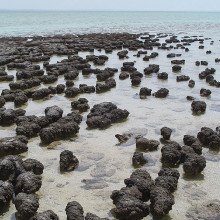
00:48 - Living rocks that changed the world
Living rocks that changed the world
with Ken MacNamara, Sedgwick Museum of Earth Sciences in Cambridge
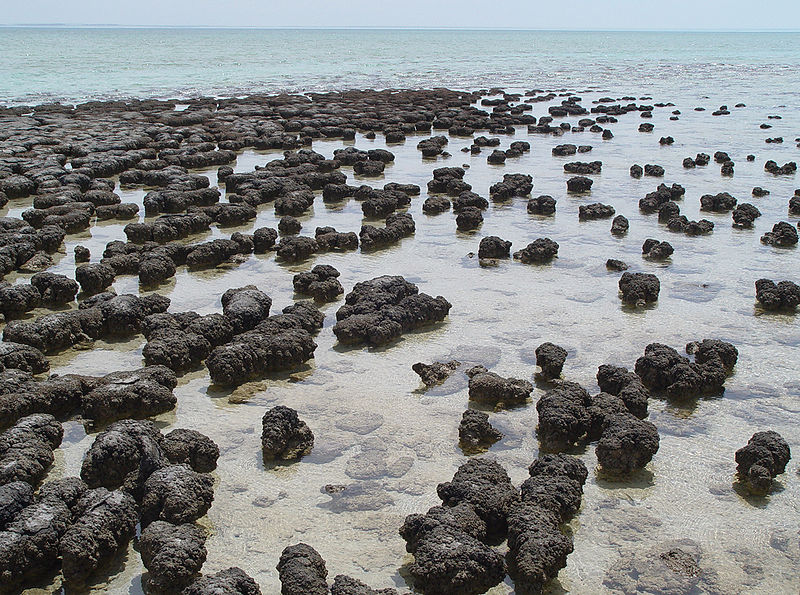 Sarah - We begin our tale in the seas of the Precambrian, around 3.5 billion years ago. Back then, the Earth was a very different place. Colder, with its much younger Sun, and with an atmosphere devoid of oxygen but packed full of so called 'greenhouse gases' like methane and carbon dioxide.
Sarah - We begin our tale in the seas of the Precambrian, around 3.5 billion years ago. Back then, the Earth was a very different place. Colder, with its much younger Sun, and with an atmosphere devoid of oxygen but packed full of so called 'greenhouse gases' like methane and carbon dioxide.
The oceans also had no oxygen and no obvious signs of life. However...
Ken - What you would find in the shallow margins of the oceans is evidence of life in the form of basically living rocks.
Sarah - Those 'living rocks', as described by Ken MacNamara, director of the Sedgwick Museum of Earth Sciences in Cambridge, are known as stromatolites, and are thought be the first evidence of life on Earth. Amazingly, they are structures that we still see today in shallow coastal areas and lakes.
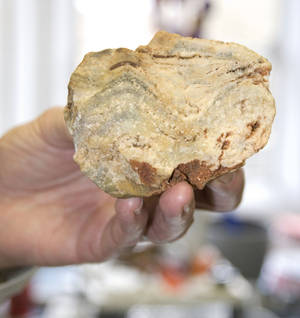 Ken - These stromatolites are basically big mounds. I always tend to liken them to rotten concrete cauliflowers. So when you go back in the fossil record what we find are layers of sediment that periodically form a little dome. And the dome might only be in some cases say 10cm high, other times they can form big domed structures some metres high. In terms of how you know these structures represent life - there's been a lot of debate about it, especially early ones - but nobody has come up with a logical way to explain how these things will form in a sediment other than by the activity of organisms.
Ken - These stromatolites are basically big mounds. I always tend to liken them to rotten concrete cauliflowers. So when you go back in the fossil record what we find are layers of sediment that periodically form a little dome. And the dome might only be in some cases say 10cm high, other times they can form big domed structures some metres high. In terms of how you know these structures represent life - there's been a lot of debate about it, especially early ones - but nobody has come up with a logical way to explain how these things will form in a sediment other than by the activity of organisms.
Sarah - The organisms responsible for building stromatolites today are photosynthesising microbes known as cyanobacteria. And just like their modern relatives, the ancient stromatolite builders not only produced food and energy directly from sunlight, but also another compound particularly important for other forms of life...
Ken - One of the arguments for the appearance of oxygen in the atmosphere and this major change from an anaerobic world where there's no oxygen in the oceans, no oxygen in the atmosphere, to oxygenated oceans and oxygenated atmosphere, is down to these cyanobacteria both ones that were constructing stromatolites and some types of bacteria that weren't stromatolite producers but were still around.
Sarah - So the early inhabitants of the oceans may have played a key role in making Earth habitable for life as we know it.
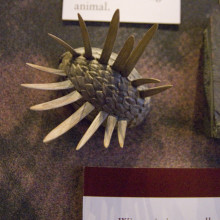
03:23 - Explosive diversity
Explosive diversity
with Alex Liu and Martin Smith, University of Cambridge
Sarah - It's not until around 3 billion years later that signs of more complex life starts to show up in the fossil record, during a period called the Ediacaran...
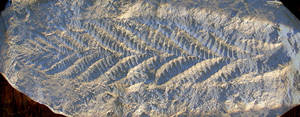 Alex - The first organisms we see at the base of the Ediacaran period are mostly algal things, little filaments and bush-shaped algal fronds. They're around 600-580 million years ago.
Alex - The first organisms we see at the base of the Ediacaran period are mostly algal things, little filaments and bush-shaped algal fronds. They're around 600-580 million years ago.
Sarah - Alex Liu from the University of Cambridge
Alex - And then around 580 million years ago just after a final large glacial event that seems to have been global in scale, we have organisms that can reach up to 2 metres or so in diameter or length. They're seen first in deep water settings, deep marine oceans around Newfoundland and in the UK today in Leicestershire, in Charnwood forest. And then as we go into younger rocks we start seeing them in places like the White Sea in Russia and in Australia in the Flinders Rangers and they're in quite shallow marine environments.
Sarah - Why the sudden appearance of diversity in the fossil record? Well, one argument is that the oxygen levels in the atmosphere and the oceans reached a threshold level, which allowed organisms to evolve to become larger and more complex. And that process could have driven further diversification...
Martin - One argument for what's change is that the arrival of animals completely reinvented the ocean ecosystems.
Sarah - Martin Smith is a researcher at the department of Earth Sciences in Cambridge...
Martin - So once you get animals feeding on these tiny little algae and unicellular 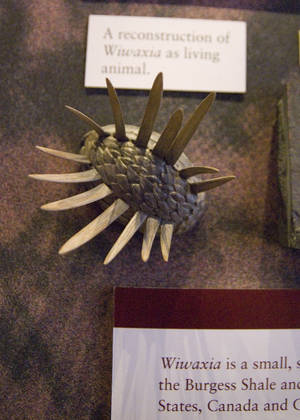 organisms they can start to squash together lots of algae and compress them into faecal pellets and basically poo algal remains to the sea floor. So as algae would have died and dissolved near the surface of the oceans now we're transporting lots of organic matter to the sea bed.
organisms they can start to squash together lots of algae and compress them into faecal pellets and basically poo algal remains to the sea floor. So as algae would have died and dissolved near the surface of the oceans now we're transporting lots of organic matter to the sea bed.
So that has two really revolutionary changes. First of all you're sucking carbon out of the atmosphere. Co2 was being fixed by photosynthesis by these algae, then dissolving and re-released. Now we've got a huge store of carbon in the ocean sediments taking Co2 out of the atmosphere and locking it up in the sedimentary record.
And that's going to change the atmospheric chemistry. The other affect that all this organic carbon on the sea floor is going to have is its now a food source and it now means that rather than a completely barren and empty sea floor you've got the potential for animals, like worms, to come along and start feeding on this organic matter on the sea floor.
Once you've got a new food source you've got great new opportunities and perhaps that contributed to diversification of animal life.
Sarah - But, this early animal life, wasn't necessarily life as we would recognise it today. Alex Liu.
Alex - In terms of their shapes they do seem very different to anything we've seen before or since. But saying that, some members of this large and diverse group do appear to possess traits and characteristics that make it seem that they might be animals.
The possible ctenophores that's been described from China, possible sponges from Australia. There are suggested echinoderms from Australia again. But all of these possible animals come from younger deposits in the latest Ediacaran around 555 million years ago. Everything before that is far more complicated and is much harder to link to know organisms.
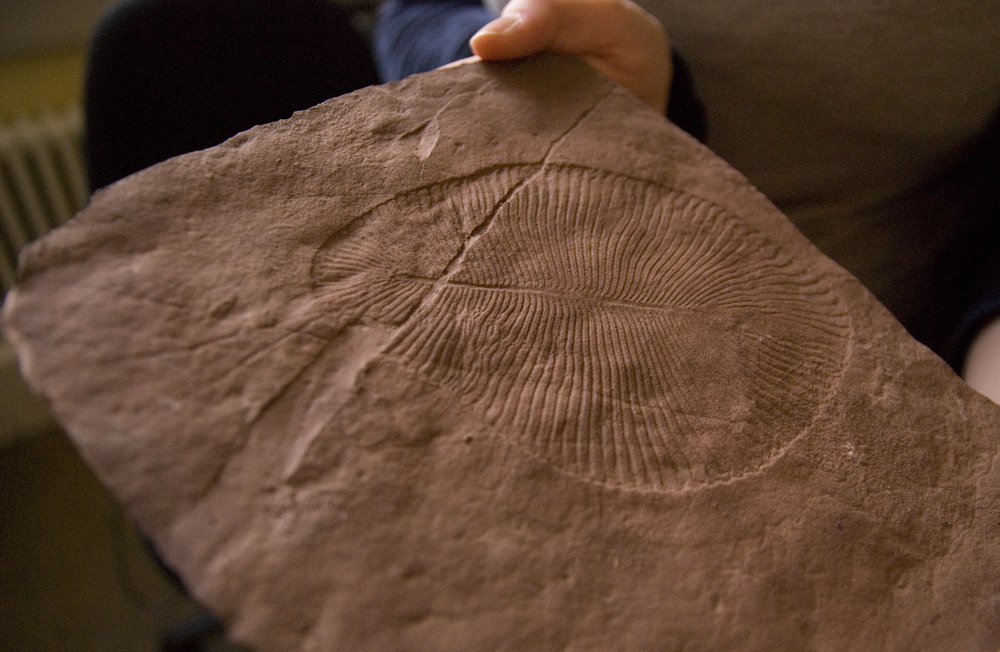 Sarah - So by around 555 million years, there are potential signs of some organisms we may recognise today. But over the next few tens of millions of years, we start to see some even more weird and wonderful organisms appear in the fossil record, during a period known as the Cambrian Explosion. We have the first evidence of complex burrowing behaviour, and the first appearance of shells and spines.
Sarah - So by around 555 million years, there are potential signs of some organisms we may recognise today. But over the next few tens of millions of years, we start to see some even more weird and wonderful organisms appear in the fossil record, during a period known as the Cambrian Explosion. We have the first evidence of complex burrowing behaviour, and the first appearance of shells and spines.
Martin - A little bit after the Cambrian explosion, 510 million years ago or so, you have these really exceptional fossil sites where an entire ecosystem has been mummified and you see not just the bones but you see all the soft parts. You see the eyes, the gills, the fins, completely organisms. So it's interesting to look at shells and bones and that tells you something new has arrived on the scene but what you're really interested in is what's underneath the shells, what's on top of the bones. And that's what you start to see in these really exceptional fossil sites such as the Burgess Shale.
If you look at the complete animals communities that you've reconstructed you see a very complex community. Almost as much diversity and disparity as you see in modern animals communities.
Sarah - And these complex communities contained members of groups that we see today - the molluscs, which includes squid and snails; the arthropods, a group including crabs, lobsters and insects, and even some of our ancient relatives - ancestors of creatures with backbones. Martin Smith again.
Martin - We're starting toe recognise that the Cambrian explosion didn't stop at the end of the Cambrian period but there is a lot of diversification in the next period, the Ordovician period. So this is 60 million years after the start of the Cambrian. It's the Ordovician when we really start to see the sub groups that we recognise today. So we have weird looking molluscs in the Cambrian, we have more familiar looking molluscs in the Ordovician. The Cambrian is a bit like looking through blurry glass at modern life. The Ordovician is looking through a clear glass. We look at an Ordovician sea and it doesn't look quite as alien as the Cambrian oceans were.
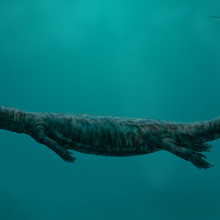
08:59 - The age of marine reptiles
The age of marine reptiles
with Hilary Ketchum, University of Cambridge
Sarah - Our next stop is not the Ordovician seas. Instead, we're jumping forward over 200 million years, past the evolution of the first sharks, with their mysterious tooth whorls and head ornaments. Past the first appearances of ray finned fish, and the lobe finned fish that travelled into freshwater and eventually onto the land, and we find ourselves in the Mesozoic, the time of the great ocean reptiles.
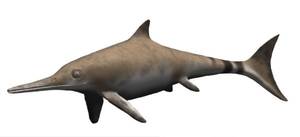 Hilary - If you were to dive into the sea during the Mesozoic you would probably see a whole range of invertebrates swimming around including relatives of the squid today like ammonites and belemnites, swimming past you. On the sea bed you'd see familiar things, clams and mussels, maybe corals and brachiopods which are not very common today but they were much more common back then. And you'd probably also chance a sighting of a marine reptile. During the Mesozoic there were at least 18 different groups of marine reptiles that invaded the sea, from all different areas of the reptile tree. And they're a really diverse group of animals.
Hilary - If you were to dive into the sea during the Mesozoic you would probably see a whole range of invertebrates swimming around including relatives of the squid today like ammonites and belemnites, swimming past you. On the sea bed you'd see familiar things, clams and mussels, maybe corals and brachiopods which are not very common today but they were much more common back then. And you'd probably also chance a sighting of a marine reptile. During the Mesozoic there were at least 18 different groups of marine reptiles that invaded the sea, from all different areas of the reptile tree. And they're a really diverse group of animals.
Sarah - Hilary Ketchum from the University of Cambridge. By the start of the Mesozoic, around 250 million years ago, reptiles were already diversifying on land - it's known as the 'Age of Reptiles', and includes the Triassic, Jurassic and Cretaceous periods, when the dinosaurs ruled the land. So what drove so many reptile groups back into the oceans?
Hilary - Following the end Permian mass extinction there was very little left in the water. Over 90% of all species particularly in the marine realm were badly hit by extinction and this left an open space for lots of reptiles to invade particularly when the sea level rose and it increased productivity in the water.
Sarah - And one of those groups of marine reptiles that flourished was the ichthyosaurs...
Hilary - They're called ichthyosaurs because that means fish lizard, but the early 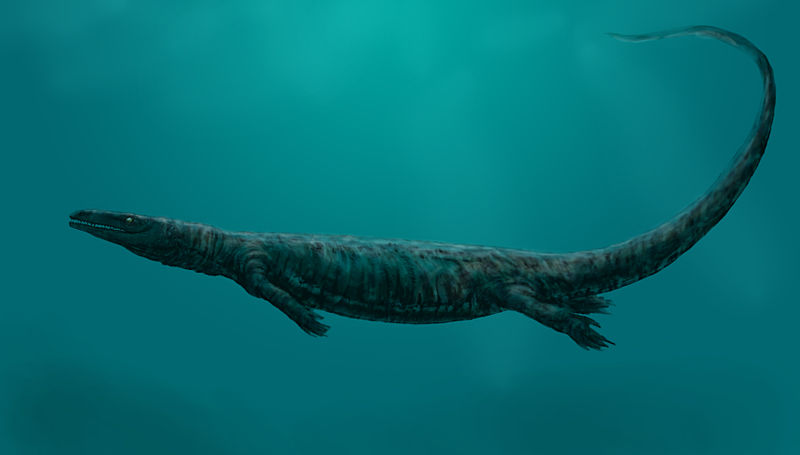 ichthyosaurs didn't look much like fish. That name was based on later ones from middle Jurassic onwards that were first found by palaeontologists. They have a very fish-like body outline, with a conical snout, lots of conical teeth and a fish-like tail which propels them through the water. But the earlier ichthyosaurs were much more eel-like in shape, they were much more diverse. Some of them got to 20metres in length. And these ichthyosaurs originated in the early Triassic about 245 million years ago at a time of really high sea level, when the sea invaded the continental shelf which provided a lot more productivity and encouraged a lot more reptiles to invade the sea. And that's why we get so much diversification of marine reptiles during that period.
ichthyosaurs didn't look much like fish. That name was based on later ones from middle Jurassic onwards that were first found by palaeontologists. They have a very fish-like body outline, with a conical snout, lots of conical teeth and a fish-like tail which propels them through the water. But the earlier ichthyosaurs were much more eel-like in shape, they were much more diverse. Some of them got to 20metres in length. And these ichthyosaurs originated in the early Triassic about 245 million years ago at a time of really high sea level, when the sea invaded the continental shelf which provided a lot more productivity and encouraged a lot more reptiles to invade the sea. And that's why we get so much diversification of marine reptiles during that period.
Towards the end of the Triassic the sea level started to fall but by that time they'd evolved their typical fish-like body plan, they'd started to invade the open oceans, and that's probably what helped them survive the end-Triassic mass extinction which was caused we think by a marine regression, so the sea levels fell. But probably because they'd evolved this open ocean-going body plan they managed to survive that.
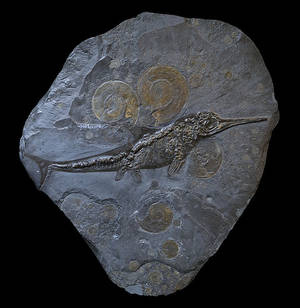 Sarah - However, the ichthyosaurs, and the other marine reptile groups, including the long-necked plesiosaurs, heavy-set pliosaurs and the mosasaurs were not so lucky towards the end of the Mesozoic. Ichthyosaurs died out around 90 million years ago, and it's not clear why, though competition from certain types of shark could be to blame. But almost all marine reptiles were wiped out at the End Cretaceous mass extinction, 65 million years ago - the extinction that also put paid to the dinosaurs on land, that was potentially caused by an asteroid impact. The only survivors of this once diverse marine reptile group live on today as sea turtles and crocodiles and their relatives. As on land, after the large reptiles were wiped out in the oceans, mammals filled some of the ecological niches left behind. So now we see killer whales and dolphins, where once we saw pliosaurs and ichthyosaurs.
Sarah - However, the ichthyosaurs, and the other marine reptile groups, including the long-necked plesiosaurs, heavy-set pliosaurs and the mosasaurs were not so lucky towards the end of the Mesozoic. Ichthyosaurs died out around 90 million years ago, and it's not clear why, though competition from certain types of shark could be to blame. But almost all marine reptiles were wiped out at the End Cretaceous mass extinction, 65 million years ago - the extinction that also put paid to the dinosaurs on land, that was potentially caused by an asteroid impact. The only survivors of this once diverse marine reptile group live on today as sea turtles and crocodiles and their relatives. As on land, after the large reptiles were wiped out in the oceans, mammals filled some of the ecological niches left behind. So now we see killer whales and dolphins, where once we saw pliosaurs and ichthyosaurs.
So, to recap our story so far. We've seen how life first began in the oceans, in the form of microbes, thriving on a planet very different from how it is now. Then, 3 billion years later, an explosion of complex life, and we start to see the beginnings of animal groups we see across the globe today. Jumping to the Mesozoic, we see some of the largest creatures ever to live in the oceans, and then see almost all of them wiped out along with the dinosaurs.
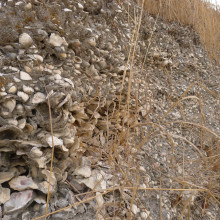
13:05 - Early humans get a taste for seafood
Early humans get a taste for seafood
with Paul Pettit, University of Sheffield
Sarah - And now, it's time to bring humans into the story, and look at the history of our relationship with the marine realm...
Paul - We can certainly tell that Neanderthals perhaps as much as 100,00 0 years ago were exploiting some sea food.
Sarah - Paul Pettit from the University of Sheffield.
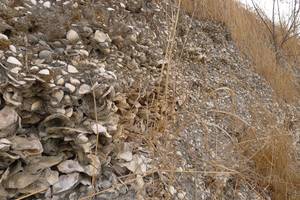 Paul - In Gibraltar for example we have two caves, Gorham's Cave and Vanguard Cave, where Neanderthals are not only carrying shellfish into these caves but they're breaking them open in predictable ways by the edge of a fire. SO this is deliberate humans consumption of these.
Paul - In Gibraltar for example we have two caves, Gorham's Cave and Vanguard Cave, where Neanderthals are not only carrying shellfish into these caves but they're breaking them open in predictable ways by the edge of a fire. SO this is deliberate humans consumption of these.
Sarah - And it's not just a case of finding debris such as shells in caves that gives us evidence that early human species were getting a taste for marine foods...
Paul - Staple isotope studies have really matured over the last 15 years or so, and the beautiful things about human beings of course is that we are to a large extent what we eat, and so our bones carry an isotopic signature of where we're deriving at least our dietary protein from. And we now have a number of stable isotope analyses on human bones way back in to the last 100,000 years of the Pleistocene particularly for Neanderthals and for early members of our own species.
And what this tells us is that marine food stuff was pretty much insignificant for the Neanderthals. If they were eating it is was probably when they happened to have a stroll on the beach and there was some shellfish around or a dolphin has just beached itself. But what they do tell us by contrast that from at least 50,000 years ago, Homo sapiens were now incorporating quite large amounts of aquatic, that is riverine, and marine resources in the diet as well. So our stable isotope analyses of that, of the carbon and nitrogen in them, are greatly complementary to what we can see on archaeological sites. They do tell us that fish is being procured in good numbers from 50,000 years ago, we may not see the means that those fish are being procured by, but they are already making a decent stamp on the diet.
Sarah - But even 50 thousand years ago, when fish and shellfish started to form a significant contribution to the diet, it still wasn't 'fishing' as we would understand it today...
Paul - When we talk about a real marine economy, getting out in ships with nets you drags behind the boats and so on, is really much later and we can count that in a handful of thousands of years rather than tens of thousands of years.
From a European perspective we call it the Neolithic or Bronze Age. And this develops as a series of island hoppings, this isn't open ocean fishing of the like that we're used to. It's probably exploiting marine resource while still in fairly easy contact with the coast, probably in many cases still in sight of a coast of one form or another.
Sarah - However these foods were collected, it's clear that they were hugely important.
Paul - Certainly coastal resources seem to have been a critical part of the evolution of our own species and we have a number of sites on the coast of South Africa and on the Horn of Africa too that reveal our own species using shellfish 100-130,000 years ago. The important thing especially when we view this in its wider dietary context, this is the time when Homo sapiens begins broadening the spectrum of their diet, in many ways, not just using the coastal and marine realm and the riverine realm, but also exploiting small animals, things that move fast, don't repay you if you have to chase them down and spear them, but do repay you very well if you're able to set traps. So when we see this broad spectrum economy coming about its very clear that our own species had reached some kid of dietary threshold in which they were far more resilient to ecological pressures, problems with the waxing and waning of resources in the landscape. So the more elements in your diet, terrestrial or marine, makes you a far better survivor, particularly in those unstable climatic and environmental oscillations of the last ice age.
Sarah - So our ancestors' ability to exploit a wide range of foods, including marine resources, undoubtedly contributed to our success and spread across the globe. That was Paul Pettit from the University of Sheffield. To find out about how we have gone on to
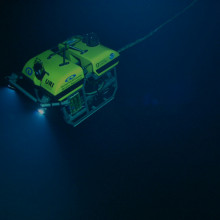
18:36 - Exploring the oceans
Exploring the oceans
with Kurt Uetz, Woods Hole Oceanographic Institution
Sarah - Humans have not only taken from the oceans. We have been exploring them, and charting them for thousands of years. One of the final realms to be explored was the deep sea. The practicalities of air supply and the huge pressures deep sea vessels had to withstand, meant that the first major expeditions to the depths of the ocean only came about in the mid 20th century.
The deep sea submersible Alvin was one of the first vehicles used for such an expedition.
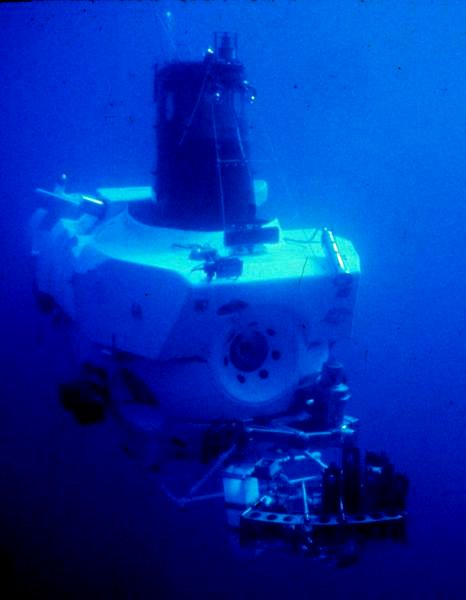 Kurt - Alvin was commissioned in June of 1964 and made its first dives soon after that.
Kurt - Alvin was commissioned in June of 1964 and made its first dives soon after that.
Sarah - Kurt Uetz from the Woods Hole Oceanographic Institution, where Alvin was developed...
Kurt - It was originally a vehicle that would go down 2400 metres and take 3 people, one pilot and 2 scientists or observers. SO its been operating for over 46 years and 4664 dives.
It still takes 2 people down, one pilot and 2 observers or scientists and we've extended its reach from 2400m to 5400m and the project now is for extending its reach down to 6500m deep. That's 98% of the ocean floor we'll be able to explore.
Sarah - And what's it like to undergo one of the dives? Cramped is probably the word. Whilst Alvin is around 7 metres, that over 20 feet long, the sphere that carries the people is much smaller...
Kurt - There sphere is about 7 feet in diameter and it is about half full of electronics and oxygen bottles and Co2 removal equipment. And then there's one pilot seat and two very low, long chairs along the very bottom of the sphere where the two scientists sit. And if you're going on a dive, the next morning, we usually dive from 5-8, you'd get inside the vehicle through the hatch on the deck of the ship and then they close the hatch and the crane lifts you into the water in less than one minute and you're released. You're completely independent of the ship. There's no tether line. And when the pilot takes you down, generally the lights are turned off or down because they're trying to conserve energy on the batteries. And to get down to 5400m is about 2 and a quarter hours.
The benefit is having a face to face interaction with the sea bottom. The benefit for science there is your perspective of what's going on. You could drive your vehicle by looking at a computer monitor but looking out the windshield gives you a much better and safer perspective. And that's where the Alvin is, being able to look out of the windows or the view ports of the vehicle to exactly what is on the bottom and you're seeing it with your own eye, gives you a better perspective, you can respond to what you thought you wanted when you went down, and now you see the real situation. It's a little bit different to looking at it on a 2D screen.
Sarah - And after that 2 and a quarter hour descent, the team can expect to spend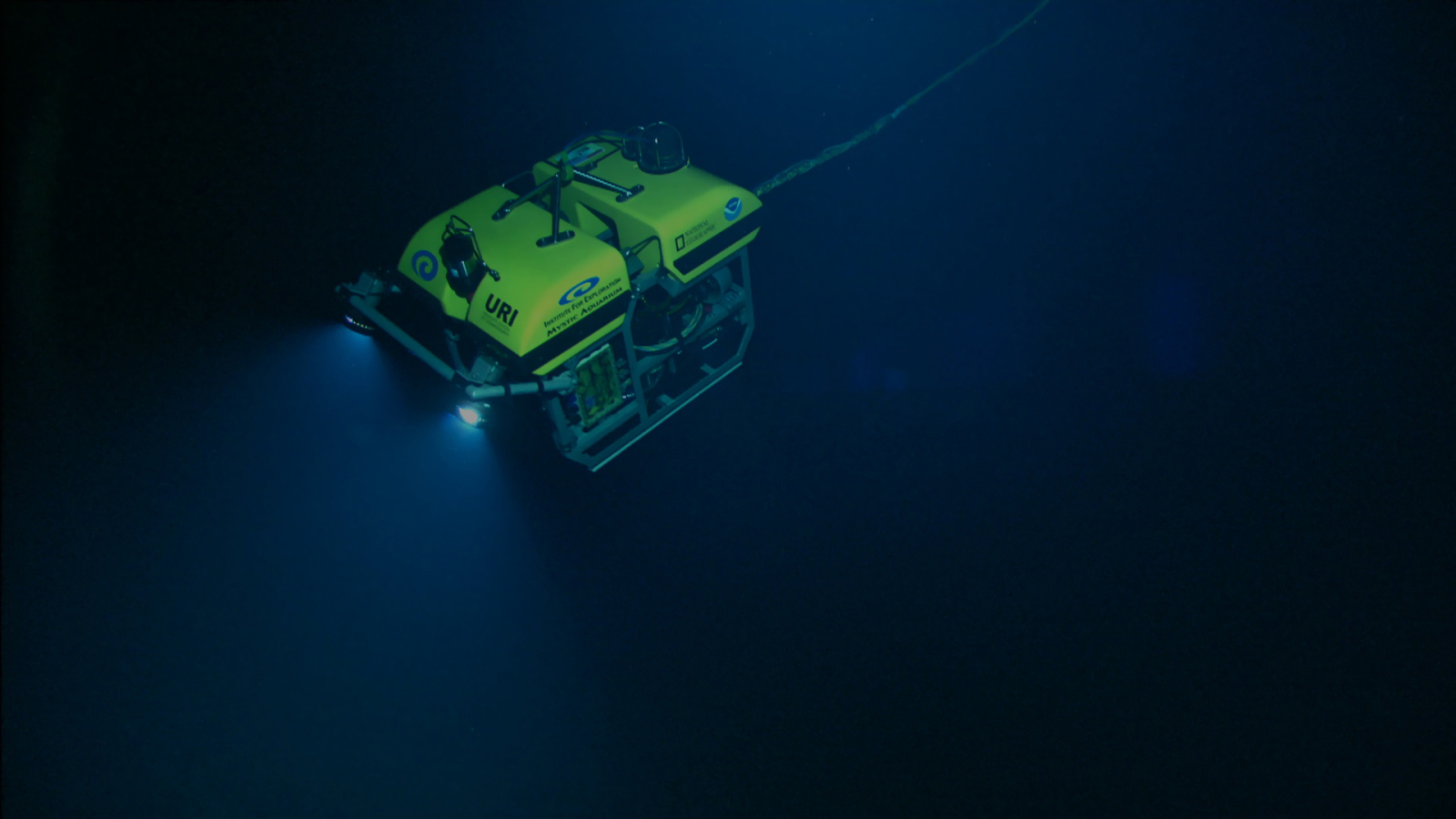 between 5-6 hours making observations through the tiny reinforced windows and taking samples using the manipulating arms. And it's that direct interaction with the deep sea environment that Kurt believes makes Alvin so special.
between 5-6 hours making observations through the tiny reinforced windows and taking samples using the manipulating arms. And it's that direct interaction with the deep sea environment that Kurt believes makes Alvin so special.
Kurt - The Census of Marine Life was the first cooperative global effort to assess everything that lives in the oceans from microbes to mammals, to the mud and sediment on the seafloor and the sea surface, and even the sea birds, from the tidal pools along the coast to the mid ocean.
Sarah - Alvin has been instrumental in improving our understanding of deep sea environments like the toxic yet incredibly diverse hydrothermal vent systems, as well as taking one of the first trips to view the wreck of the Titanic.
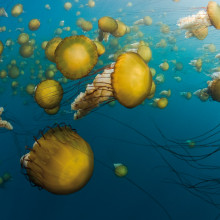
22:29 - Searching for ocean biodiversity
Searching for ocean biodiversity
with Jesse Ausubel, Sloan Foundation
Sarah - In our final milestone in the history of life in the Oceans - the Census of Marine Life.
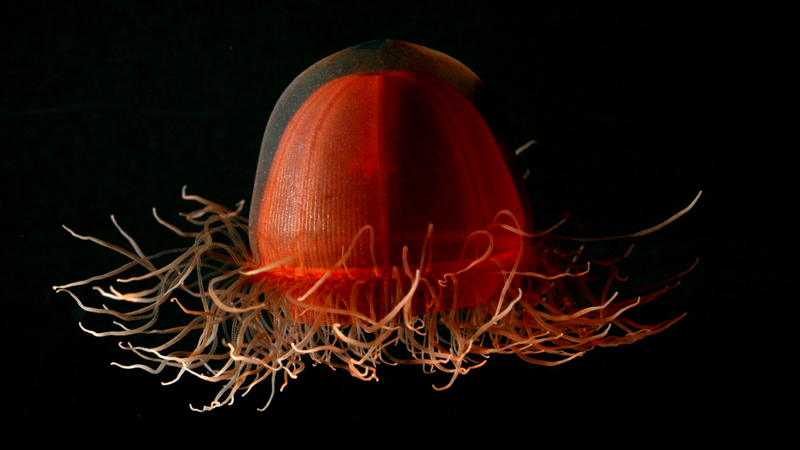 Jesse - The Census of Marine Life was the first cooperative global effort to assess everything that lives in the oceans from microbes to mammals, to the mud and sediment on the seafloor and the sea surface, and even the sea birds, from the tidal pools along the coast to the mid ocean.
Jesse - The Census of Marine Life was the first cooperative global effort to assess everything that lives in the oceans from microbes to mammals, to the mud and sediment on the seafloor and the sea surface, and even the sea birds, from the tidal pools along the coast to the mid ocean.
Sarah - That's Jesse Ausubel, one of the founders of the Census. So what drove him, and his partner in the Census Fred Grassle, to attempt such a huge project?
Jesse - There's tremendous concern in the oceans about what's known and what's unknown. What's know keeps changing of course because the environment is always fluctuating, because fishing is removing life, but we also know that most of the ocean maybe 90% is really unexplored in a serious, careful way for marine life. So, people have been talking about shifting baselines, well we know things were different in 1950 or 1850 or the year 1500 so the core group of us said maybe it's time for everybody all around the world to join together and really look in a big way, in an integrated, cooperative way, using the newest technologist, let's really try for the first time to create global baselines for all species, for all regions, and that was really our goal.
Everybody said to us your crazy but no one said don't do it.
Sarah - Over 6000 new species were described during the Census, and the first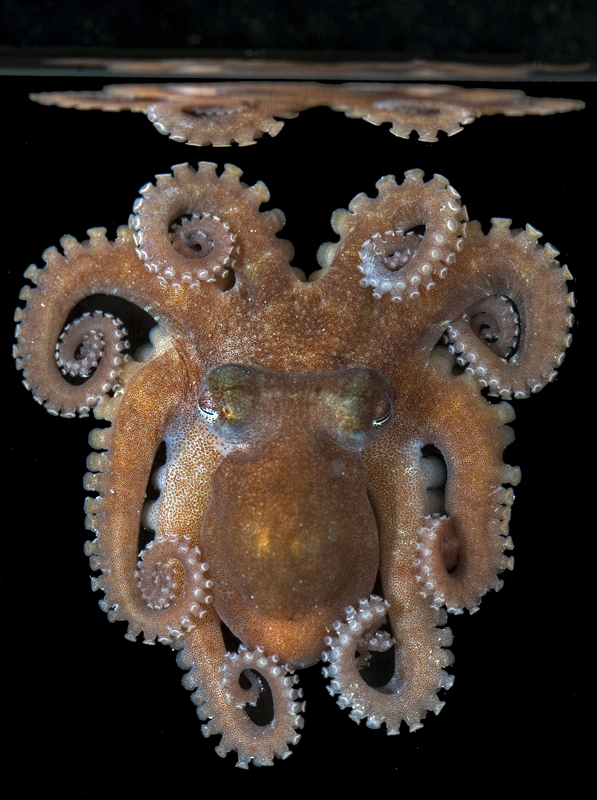 official list of all known species in the oceans was made - a list with over 250 thousand species on it, but that could be missing up to three times that number of species that we are yet to discover. There was also the discovery of an area in the Pacific just off the west coast of the United States now dubbed the 'Blue Serengeti', essential for migrations of dozens of large ocean species. If you want to know more about some of the discoveries of the Census, do check out our website, where we have interviews from some of the researchers involved.
official list of all known species in the oceans was made - a list with over 250 thousand species on it, but that could be missing up to three times that number of species that we are yet to discover. There was also the discovery of an area in the Pacific just off the west coast of the United States now dubbed the 'Blue Serengeti', essential for migrations of dozens of large ocean species. If you want to know more about some of the discoveries of the Census, do check out our website, where we have interviews from some of the researchers involved.
So what has been done in the last two years with all this information about the state of the oceans?
Jesse - Most of the nations of the world have signed the treaty called the Convention on Biodiversity, that keeps ratchet ting up and introducing stronger measures for conservation of biodiversity The work of the census provided the basis for the definition of areas that would be especially important to protect in the oceans, especially the high seas, the ecologically and biologically significant areas. And just a couple of weeks ago a the big meeting of politicians and managers involved with this global convention on biodiversity, a whole set of new marine areas were identified for protection.
Sarah - A step in the right direction for protecting the oceans. So how does it feel after ten years of hard work, and the release of results that have changed our understanding of life in the oceans and are helping to shape our protection it?
Jesse - Personally for me it was an incredible journey. I've learned enormous amounts, I've made many new friends and I had great adventures on ice floes in the Arctic Ocean and the Great Barrier Reef. But I think the 2700 people participating would tell you that the same that working together cooperatively we all did something that non of us alone or in a small group could have done, just the joy of discovery is immense but then the fact that the knowledge is valuable and can help life in the oceans, I think was also at least as gratifying.
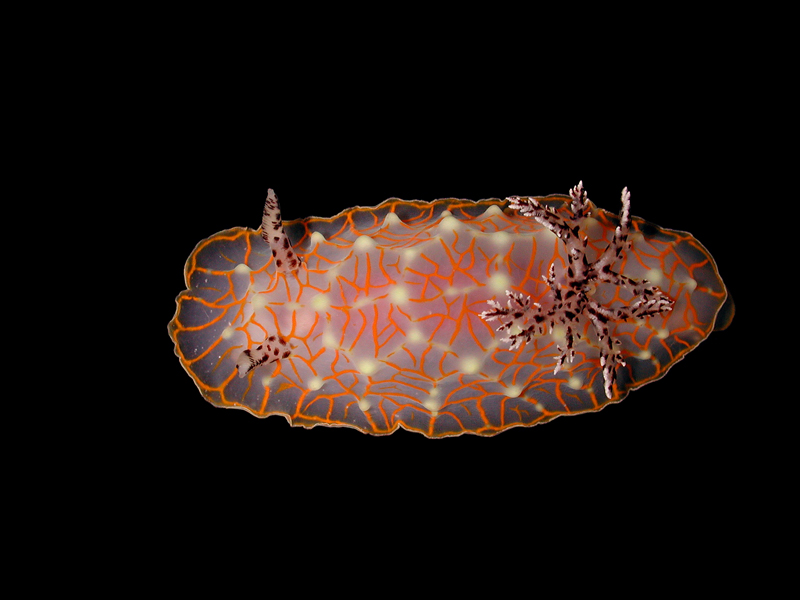 Sarah - Jesse Ausubel, one of the founders of the Census of Marine Life.
Sarah - Jesse Ausubel, one of the founders of the Census of Marine Life.
And that's it for our journey through the history of life in our seas. We've heard about early microbes altering the atmosphere of the early Earth, Neanderthals breaking open shellfish by the fireside and how global scientific collaboration can lead to extraordinary things.









Comments
Add a comment